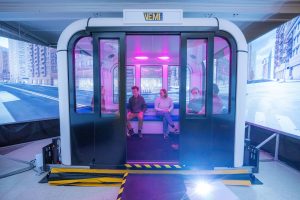VEMI Lab debuts custom-built multi-person autonomous vehicle simulator
The VEMI Lab at the University of Maine has launched its custom-built multi-person autonomous vehicle simulator, a unique platform for human-subject research in the automotive space.
VEMI’s Multimodal Omnidirectional Immersive Simulator for Inclusive Navigation or MOISIN (pronounced “mo-sheen”) is unique as the first fully autonomous “people mover” or “robo-taxi” motion simulator, designed as a replacement for the human-driven taxis or ridesharing services available today. It has no steering wheel or pedals, and its cabin — outfitted with multi-directional seating for up to six people — sits atop a motion platform powered by actuators that give passengers the feeling of movement on the roads. Realistic cityscapes are projected onto 360-degree screens surrounding the unit, and integrated audio systems simulate both on-board and environmental sounds for a fully immersive experience.
Members of the UMaine community, the public and the media are invited to visit the lab on Friday, April 7, from 4–6 p.m. for an open house featuring simulator demonstrations and a chance to meet VEMI students and staff. If you’d like to attend, please RSVP.
“At the VEMI Lab, our core focus is on humans, and that’s precisely why we chose to build a multi-person AV simulator,” says lab director Richard Corey. “We’re primarily interested in a concept that we refer to as human-vehicle collaboration, which encompasses the needs of the people in the vehicle, the needs of the vehicle, and where those needs intersect.”
A key research question involves exploring inclusive technology solutions that will help ensure that future AV technology serves the widest set of user needs possible.
“Fully autonomous vehicles have the potential to meaningfully expand transportation options for many individuals who aren’t able to drive — notably the blind and visually impaired, including older adults — but only if they are designed inclusively,” says VEMI chief research scientist and professor of spatial computing Nicholas Giudice. “What we call human-vehicle collaboration is a new frontier in human-computer interaction and one that will be increasingly important as we transition toward a future in which AVs are the dominant mode of transportation. Our research aims to ensure that the full range of user needs are considered in that transition.”
Maine offers a unique environment and opportunity to conduct autonomous vehicle research and testing with a cold-weather climate, diverse road infrastructure (from major highways to urban centers to logging roads), and an aging, rural populace that will greatly benefit from the availability of AVs. These factors are drawing automotive industry interest to Maine and creating new opportunities for research and development.
It was the recognition of this opportunity that led the VEMI Lab to design and build MOISIN, which, like many VEMI projects, has been driven by student involvement. The software that runs the simulator and the virtual worlds within which it operates were created by student-led programming teams using Unity and Unreal Engine, interior electrical components (including LED lights and audio systems) were designed and implemented by students and staff, and VEMI students named the simulator. VEMI would also like to acknowledge collaboration with UMaine’s Advanced Manufacturing Center, which has provided design and engineering support.
Part of the College of Liberal Arts and Sciences, VEMI attracts students from a range of disciplines, including biomedical engineering, computer science, interdisciplinary studies, mechanical engineering, psychology, physics, spatial computing, and more.
“Working on MOISIN has been an amazing experience,” says Anthony Caccese, a junior majoring in computer science. “When developing for a machine like this, there are a lot of things that need to be just right for a realistic experience. It’s not only the dynamics of the simulator, but also other things, like having realistic graphics and making sure the motion of the vehicle and the graphics are in lockstep. It’s been a lot of fun applying different concepts that I’ve learned over the years and I’m grateful to have gained this outside-the-classroom experience developing for such a unique project as an undergraduate.”
With assembly complete and initial simulations set up, the VEMI Lab team is working on additional software builds, multisensory user interfaces, and engineering development to refine the experience in preparation for research studies with human participants and continued collaboration with the automotive industry.

